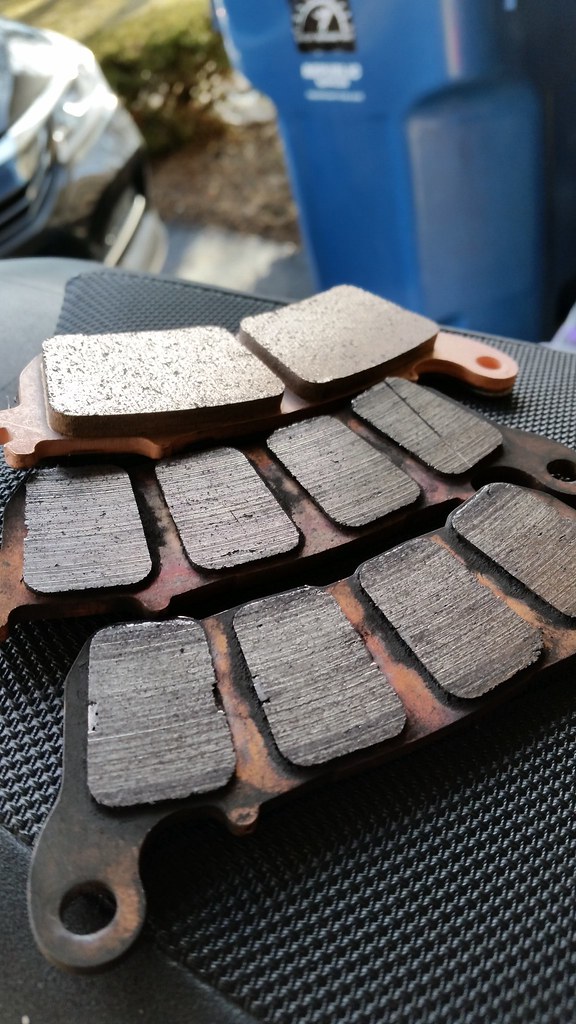OriginalRocket
Member
- Joined
- Oct 4, 2012
- Messages
- 559
- Reaction score
- 3
- Points
- 16
- Location
- Mokena, Illinois, USA
I rolled over 13,500 miles on my 2012 NC700X and besides a seat, windshield, handle bar riser mod I've done little else besides a couple oil changes, and a valve adjustment at 10,000.
Well this winter I decided it was time for a major overhaul. On the list is the following:
-New F/R tires (Michelin PR 4's)
-New Chain (DID vx2)
-New sprockets F/R (staying stock 16/39) Not sure what brand to use.
*-Change Front brake pads (EBC Sintered HH)
*-Exchange brake fluid (Castrol DOT4)
-Change oil, oil filters (Rotella 5w-40, FRAM Ultra 7317, Honda OEM Transmission Filter)
*-Change air filter (Honda OEM Filter)
*=Completed
So far time and funds have allowed me to accomplish the entire brake system and air filter. Here are a few photos of that day. Mind you these are the original brake pads and air filter from when I bought the bike new in October 2012.



Thoughts: I will extend air filter change to 20,000 mile intervals based on what I have seen. I hope these EBC brake pads last longer, if not they are less than half the cost of Honda OEM, I just hope they are nice to the rotor, or I will go Kevlar(organic) Brake fluid will always be exchanged when I do pads, its cheap enough and I bought a brake fluid exchange kit which makes it super easy and quick. I did do both front and rear fluids, Rear brake looks like new. I don't usually use it unless emergency or hard braking is needed.
My tires are still stock and they need to be changed. I have the minimum tread depth left, they are almost at the wear bars, maybe .5mm both front and rear. Don't mind the other bikes, they are a (brother-in-law) 2014 Yamaha FZ8,(sister-in-law) 2015 CBR300, (wife's) 2013 CBR250. I store and work on them for fun (they pay for parts) over the winter.
Any other thoughts/comments/ideas from the public are welcomed.
Well this winter I decided it was time for a major overhaul. On the list is the following:
-New F/R tires (Michelin PR 4's)
-New Chain (DID vx2)
-New sprockets F/R (staying stock 16/39) Not sure what brand to use.
*-Change Front brake pads (EBC Sintered HH)
*-Exchange brake fluid (Castrol DOT4)
-Change oil, oil filters (Rotella 5w-40, FRAM Ultra 7317, Honda OEM Transmission Filter)
*-Change air filter (Honda OEM Filter)
*=Completed
So far time and funds have allowed me to accomplish the entire brake system and air filter. Here are a few photos of that day. Mind you these are the original brake pads and air filter from when I bought the bike new in October 2012.



Thoughts: I will extend air filter change to 20,000 mile intervals based on what I have seen. I hope these EBC brake pads last longer, if not they are less than half the cost of Honda OEM, I just hope they are nice to the rotor, or I will go Kevlar(organic) Brake fluid will always be exchanged when I do pads, its cheap enough and I bought a brake fluid exchange kit which makes it super easy and quick. I did do both front and rear fluids, Rear brake looks like new. I don't usually use it unless emergency or hard braking is needed.
My tires are still stock and they need to be changed. I have the minimum tread depth left, they are almost at the wear bars, maybe .5mm both front and rear. Don't mind the other bikes, they are a (brother-in-law) 2014 Yamaha FZ8,(sister-in-law) 2015 CBR300, (wife's) 2013 CBR250. I store and work on them for fun (they pay for parts) over the winter.
Any other thoughts/comments/ideas from the public are welcomed.



